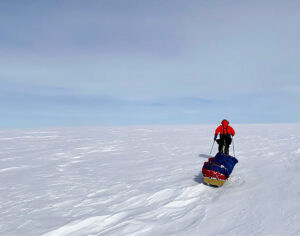Earlier this week, McDonald’s announced that it was temporarily shuttering all 850 restaurants in Russia as a response to the war in Ukraine. But few know that McDonald’s first got permission to open in Russia thanks in part to a polar expedition.
I was there when a group of polar explorers paved the way for McDonald’s entry into the Soviet Union. Here is the untold story.
McDonald’s and the Soviet Union
From the perspective of those born after 2000, it may seem surprising that McDonald’s had to fight its way into the former Soviet Union. But until the 1990s, the Soviet Union was largely closed off to the West, and foreign businesses were not welcome.
Then by the late 1980s, Soviet President Mikhail Gorbachev and his glasnost policy were beginning to open up the country to the rest of the world for the first time in 70 years.
Skiing to the North Pole
A few years before this, in 1979, Moscow mathematician Dmitri Shparo led a group of fellow Russians to the North Pole on skis. The Soviet Union didn’t have plastics or fiberglass, so rather than tow sleds, they carried 45kg backpacks. Airplanes dropped them fresh supplies every couple of weeks. Other adventurers had reached the North Pole with dogs previously, but this was the first ski journey. Shparo became a household name in the Soviet Union after this success.

Dmitri Shparo. Photo: Jerry Kobalenko
Shparo saw glasnost as an opportunity to reopen an old idea: to ski across the entire Arctic Ocean from northern Russia to Canada via the North Pole.
The Canadian government agreed in principle. But it insisted that several Canadians be part of the expedition.
I was involved in the early training stages. First, a group of us went to Kazakhstan and Kyrgyzstan in 1987 to trek the Tien Shan mountains.

Canadian Gilbert Rioux fords a wild glacial river in Kazakhstan. Photo: Jerry Kobalenko
Then the Russians came to Canada that November to train on Baffin Island and to fundraise for the expedition. However, as one Soviet explorer explained, “In our country, there is always money if necessary. What is needed is permission.”
McDonald’s negotiates business in the Soviet Union
George Cohon, the head of McDonald’s Canada, had been negotiating for some time to get that cherished permission from the Soviets to open the first McDonald’s in Moscow — the first of many. By now, Shparo was extremely well-connected politically. Allies included the number three man in the Kremlin at that time, Alexander Yakovlev.
In meetings, Cohon was given to understand that sponsoring Shparo’s venture would be appreciated. Almost immediately, he cut a cheque for $25,000 to the expedition, which had come to be called Polar Bridge.

Photo: Jerry Kobalenko
In the end, eight Russians and four Canadians crossed the Arctic Ocean successfully in 1988. Some months later, Cohon received approval to open the first McDonald’s in Moscow.
By the time the restaurant opened on Pushkin Square in early 1990, the country had radically changed even from 1987. When we first visited Moscow, you could be executed for selling Western blue jeans on the street. Reselling at a profit was spekulatsia, or speculation, and considered capitalism in its worst form.
By 1990, glasnost had come so far that many Russians wanted to be Americans. They were tired of scratching out a working-class life while all of us in the West, so they believed, were millionaires. The “Big Mak” that they could buy at the new McDonald’s briefly came to symbolize this better life.

Symbol of a rosy future: McDonald’s first restaurant in Moscow, 1990. For months, thousands of Russians lined up every day for a taste of the West. Until yesterday’s closures, about 850 McDonald’s were operating in Russia by 2022. Photo: Jerry Kobalenko
Although I hadn’t joined Polar Bridge in the end, I spent months in Russia every year at that time. The Russians’ optimism and infatuation with the West lasted until about 1992. Hyperinflation the year before had destroyed most people’s life savings. “When my husband and I got married,” one woman told me, “our parents gave us enough money to buy a flat. Now the money can buy two books of matches.”
Standards of living plummeted. A few previously well-connected people walked into former state factories and said, “I own this now.” They quickly became well-off and evolved into oligarchs.
Everyone else became disillusioned. They weren’t going to become millionaires with the fall of the Soviet Union, after all. At that time, Russia had virtually no middle class, just a handful of rich people and a vast underbelly of those who were even poorer than they ever had been.
Yet throughout this time, Western businesses continued to expand throughout Russia. Pizza Hut, Baskin Robbins, and McDonald’s were among the first chains to gain a foothold, even though few people could afford them. Their neon signs were a weird oasis of light in the dark Moscow twilight. Until this, Moscow had zero neon — hard to imagine in a city of this size. Even Pyongyang, North Korea glitters with neon at night nowadays.
Some Western restaurants springing up at that time to serve expats in Moscow only accepted “hard currency” — U.S. dollars, Japanese yen, etc. But from the beginning, McDonald’s took rubles. It allowed a taste of the West to ordinary Russians willing to splurge half a day’s pay.

A handful of early bars and restaurants catered to Westerners in Moscow and only accepted foreign currency, but McDonald’s took rubles from the start. Photo: Jerry Kobalenko
The dire poverty and periodic hyperinflation, coupled with the growing fortunes of a handful of individuals, persisted through much of the 1990s. In 2000, Vladimir Putin came to power. It was better for a while. A middle class grew. Now it’s returned to its brutal Soviet roots.
This is a very simplistic view, but it’s how McDonald’s came to Russia, and perhaps how this symbol of a better life has left for the foreseeable future.





